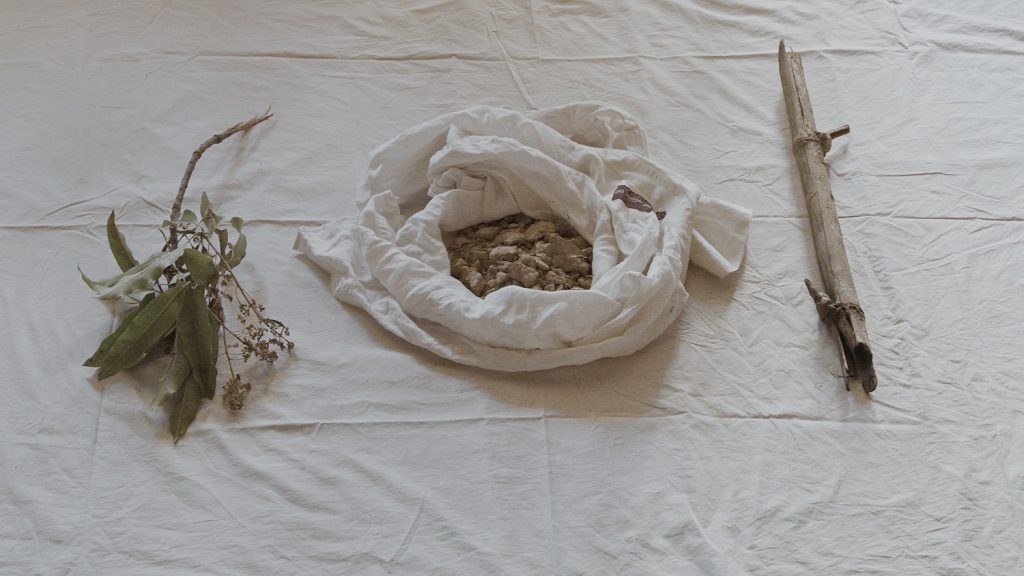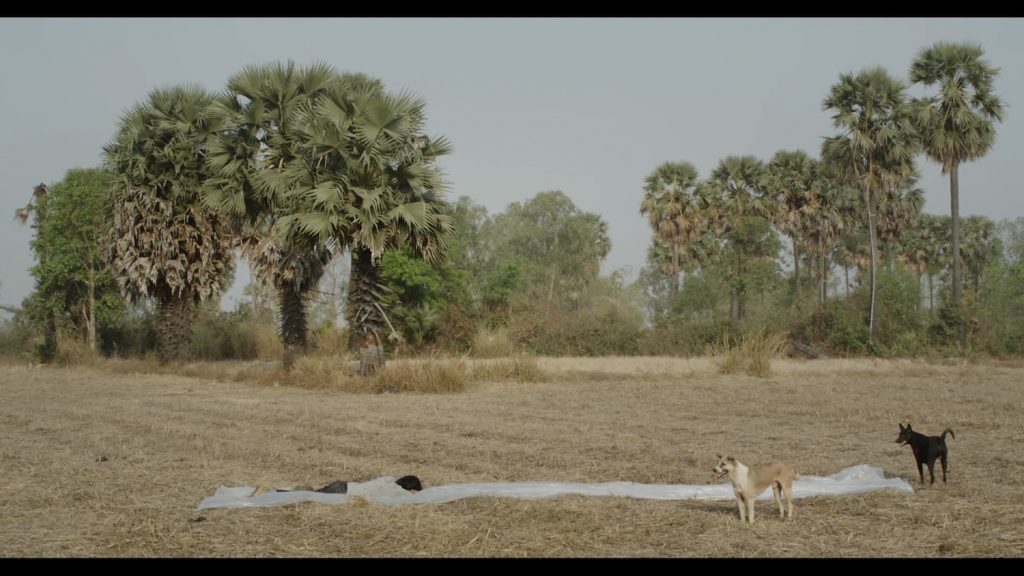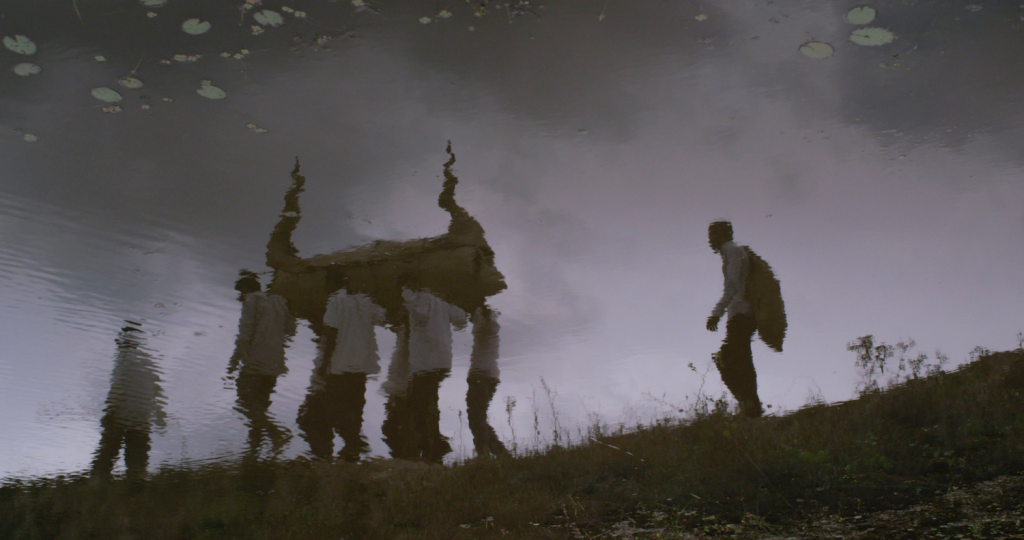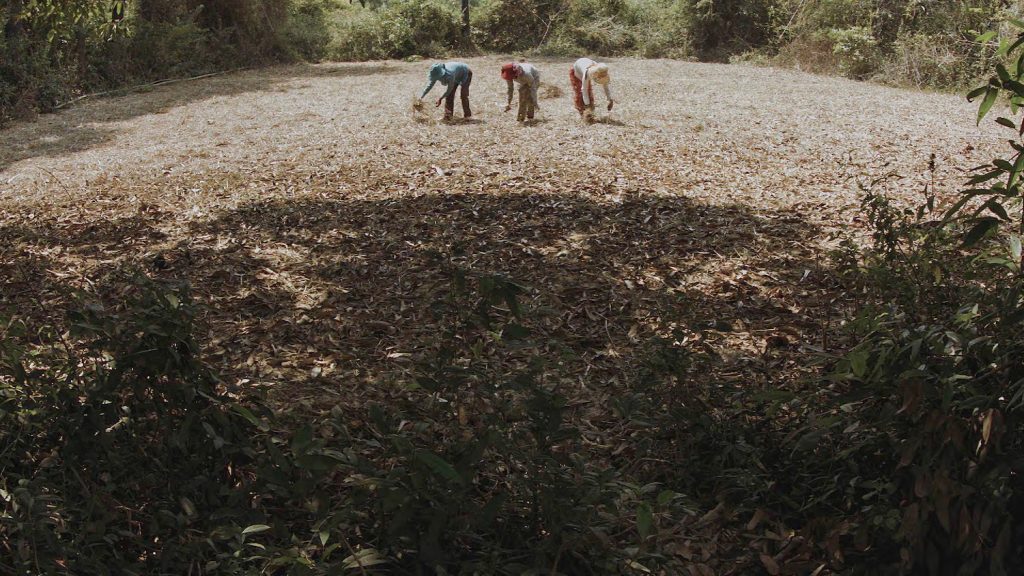
23.11.2020
In today’s climate of globalizing polarisation, curator Andrea Fam revisits Khmer artist, Vandy Rattana’s Monologue Trilogy which provides a timely reminder of our anthropological propensity to historical amnesia, and resilience.

These words, seemingly timeless musings, were penned by Khmer[2] artist Vandy Rattana as part of an early script for the third film of his Monologue Trilogy, … far away, over there, the ocean (forthwith referred to as … far away).[3] The trilogy uses reflections on historical facts and fiction and speculative reality[4] set against a backdrop of rural Cambodia to locate and observe the potential of embodied trauma as a method for moving through space and time. The films take as their starting point the truths and speculations about the Khmer Rouge genocide and contemplate the legacy it has left on the psyche of the Khmer people and the landscape of the country. Coursing through the roots in the soil and the veins in society is the pulse of this incident, where the horrors of the past sleep. Soil takes society’s lead; detached, the land lays idle as the echoes of history swirl in the atmosphere.
How should one think about trauma? Who is entitled to think about trauma? And what about countries like Cambodia, where spiritual guidance and a tradition of presentism blend with mythology to weave together an entangled tapestry of faith in divine intervention?
The films MONOLOGUE (2015), … far away (2019), and Funeral (2018) comprise Vandy’s Monologue Trilogy. MONOLOGUE addresses Cambodia’s violent past. It is a study of the nature of trauma—how it collapses time and space and makes taking distance from history an impossible task. Both personal and public in nature, the film documents a small plot of land near the rural Banteay Meanchey province located in the far northwest of Cambodia (a region formerly known as Battambang), where Vandy’s sister and grandmother were discarded and buried alongside five thousand others during the Cambodian genocide under the Khmer Rouge regime, which would result in the death of between 1.5 to 2 million people by the end of its reign in 1979.[5]

Funeral opens to the sound of a voice speaking about the release of slaves who “wonder for a moment about their existence and their freedom. Death settles the course of life. The dream also burns and will soon find its origins. The civilization born of dreams fades, darkens, and collapses. Already it reaches a point where everything is fragile and deadly.” The viewer wonders, Who are these slaves? To whom are they enslaved? Are all humans not slaves to themselves, often captured within self-made cycles of illusions and ghosts of memories of the past? Are we trapped by our anxiety of both the known and unknown?

In Funeral, Vandy again considers notions of death and the afterlife, but whereas the research for MONOLOGUE was rooted in the stories of survivors of the Khmer Rouge regime, in Funeral Vandy incorporates a fictionalized narrative of Khmer myths and legends to tell the story of humanity. Humans have rich and layered relationships with traditional tales; “Myths exist in all countries for I think humans are mythical creatures, full of imagination. Human knowledge is not sufficient enough to reach the truth or to reach other dimensions of life so myth or imagination is necessary to hold the community at some occasions,” reflects Vandy. One place in particular that embodies an abundance of mythical narratives is the Khmer national monument and UNESCO World Heritage Site Angkor Wat.
The second film of the trilogy and last to be produced,…far away follows the character of a young painter who believes landscapes do not exist, but that they are sensations produced by fragments of life experiences, created by humans as projected illusions of beauty. “Maybe the landscape is the mirror in which I can see myself through the light particles. My image in the mirror has no flavor, no smell, no warmth, rather it is the pain of wanting to become something. I’m always wondering if the landscape is an infinite dream,” the protagonist of the film reflects while standing amidst a sea of plaster-cast limbs, haphazardly strewn across a sandy field of reeds.

In … far away, Vandy was inspired by the language of surrealism to break from rationality. He composed a narrative that attempts to highlight the metaphysical realism of the universe.[6] Through arrangements of both visual aesthetics and text, he attempts to free us from the dictate of thought as controlled by reason. In this film, gender has no binary, moments are fractured in time, and humanity’s under- and ‘overmining’ of objects—the process through which we attempt to reduce objects to the parts of their sum or sum of their effects[7]—prove to unsettle, confuse, and facilitate our sense of being lost, always searching. What should we believe?
Rationality is broken.
~
The trilogy carries within it complex and complicated human emotions and experiences of loss. A loose scaffold of the stages of grief can be used to unceremoniously anatomize the artist’s largest project to date. One could describe MONOLOGUE as Vandy’s assessment of information, a matter of fact—but no less moving—manner in which to process and re-file his personal history. His repeated attempts at producing a second film would locate pain and anger, emotions he did not want to give the universe the satisfaction of receiving. The cyclical nature of history narrated in Funeral reveals a realist’s cynicism to the way life turns. And carried within …far away is a personal acceptance and exploration of humanity’s continuous search for who we are in a world that does not stop changing. This example of the stages of grieving in no way trivializes the personal and collective history that Vandy and the Khmer people experienced, nor does it discount the mastery of his cinematic endeavor. Instead, it attempts to highlight the human quality of being arrested by emotion as well as how time and space fold, enfold, and unfold in the trilogy, offering nonlinear points of entry into its narratives.

~
Humans meld memory with imagination; accounts of incidents form and reform, morphing through subtle lapses in recollection or challenges to the narrative. How does one (re)read memories of trauma that resist reckoning or mapping? Is it necessary to recall memories in order to grieve or mourn? And beyond this, we must wonder if we place too much emphasis and expectation on ‘mourning’ as a convention for loss?
For the Khmer, their presentism roots them in the current, where the past has already occurred (and to some, is no longer real) and been internalized, though it may hardly be mentioned, let alone discussed or questioned. For Vandy, the process of working through trauma, both personal and collective, has challenged him to engage in modes and mediums of artistic production hitherto unexplored, and in doing so, he has allowed us to share in his quest to break out of our Camusian universe. The Monologue Trilogy provides an opportunity to look at the reflection of an unconventional mirror, where we may regard both the folly and resilience of humanity.
~
Watch the videos:
MONOLOGUE (2015)
… far away, over there, the ocean (2019)
Funeral (2018)
Excerpt from an email exchange between artist Vandy Rattana and the author, his then curator during the Singapore Biennale, for which … far away, over there, the ocean was commissioned. March 27, 2018.
The English word “Cambodia” is an anglicization of the French Cambodge, which is in turn the French transliteration of the Khmer Kampuchae. The country is Kampuchae, and its people are Khmer. The name “Cambodia” is used in many native English-speaking countries, while Kampuchae is used in Asia, particularly in the Indochina.
The title of this essay borrows from the title of this film.
The term speculative reality is a nod to the philosophical movement of speculative realism as coined and developed by Ray Brassier, Iain Hamilton Grant, Graham Harman, and Quentin Meillassoux.
The Cambodian Genocide was the systematic killing of nearly 2 million Khmer at the hands of the Khmer Rouge, the popular name of the Communist Party of Kampuchae, led by Pol Pot. The radical leadership sought to root out those tainted by the capitalist West to create a ‘purified’ Kampuchae, one that harked back to the mythic past of the Khmer Empire. Prime targets for this persecution were the cultural elites whose thinking and teachings were said to be wholly unacceptable and did not belong under the communist regime. The educated, including doctors, lawyers, and current or former police and military, were targets, as were Christians, Buddhist, and Muslims, in order to create a society without competition. These killings would rid a country of an entire generation of thinkers, a loss which is reflected in the slow development of the economic and cultural landscape in Cambodia today.
Metaphysical realism is the view that objects exist in reality outside human cognition. It considers a universe independent of humans; the universe is more than the consciousness of human beings.
Graham Harman, Quentin Meillassoux: Philosophy in the Making (Edinburgh: Edinburgh University Press, 2011), 10-12.
Comments
There are no coments available.